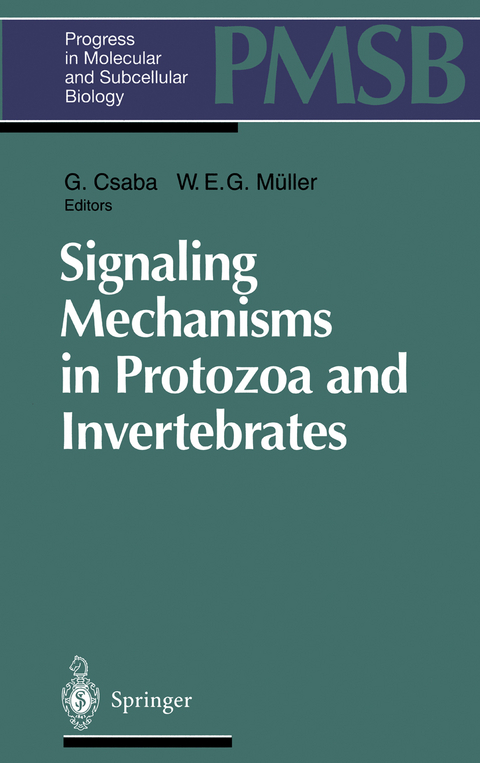
Signaling Mechanisms in Protozoa and Invertebrates
Springer Berlin (Verlag)
978-3-642-80108-2 (ISBN)
Evolutionary Significance of the Hormone Recognition Capacity in Unicellular Organisms. Development of Hormone Receptors.- 1 Introduction.- 2 Receptor Memory: Hormonal Imprinting.- 3 Problems of the Specificity of Imprinting.- 4 Time, Concentration, and Downregulation.- 5 Sugars of the Receptors.- 6 Cell Aging and Imprinting.- 7 Imprinting by Amino Acids and Oligopeptides.- 8 Receptors of the Nuclear Envelope.- 9 Possible Mechanisms of Imprinting.- 10 The Other Component: Hormones in Protozoa.- 11 Evolutionary Conclusions Based on the Unicellular Model.- References.- Studies on the Opioid Mechanism in Tetrahymena.- 1 Introduction to Opioid Mechanisms.- 2 The Opioid Mechanism in Tetrahymena.- 3 Conclusions.- References.- Adenylate and Guanylate Cyclases in Tetrahymena.- 1 Introduction.- 2 Cyclic Nucleotide Metabolism in Tetrahymena.- 3 Cyclases Involved in Cell Metabolism and Functions.- 4 Regulatory Mechanisms of Cyclases.- 5 Structure and Intracellular Distribution of Calmodulin.- 6 Conclusion.- References.- Signal Peptide-Induced Sensory Behavior in Free Ciliates: Bioassays and Cellular Mechanisms.- 1 Introduction.- 2 Peptide Signals in Ciliates.- 3 Bioassays Measuring Peptide-Induced Changes of Cell Behavior and Ciliary Activity.- 4 Cellular Mechanisms Related to Peptide Action on Individual Cell Behavior.- 5 Concluding Remarks.- References.- Ciliate Pheromones.- 1 Introduction.- 2 Background.- 3 Pheromone Notation and Origin.- 4 Pheromone Secretion and Purification.- 5 Pheromone Structure.- 6 Pheromone Genes.- 7 Pheromone Receptors.- 8 Competitive Pheromone Receptor-Binding Reactions.- 9 Pheromones as Growth Factors.- 10 Concluding Remarks.- References.- Cell-Surface GPI Expression in Protozoa. The Connection with the PI System.- 1 Introduction.- 2 The Cell-SurfaceExpression of GPI-Anchored Proteins in the Protozoa.- 3 Inositol Phospholipids in Tetrahymena pyriformis. The Possible Link Between the PI System and Synthesis of GPI.- References.- Cell Adhesion Proteins in the Nonvertebrate Eukaryotes.- 1 Introduction.- 1.1 History and Philosophy.- 1.2 Evolution.- 2 Approaches and Findings.- 3 Protista.- 4 Higher Eukaryotes.- 5 An Alveolate: Plasmodium.- 6 Plants.- 7 Fungi.- 8 Metazoa.- 9 Conclusions.- 10 Characteristics of Cell Adhesion Proteins.- 11 Extracellular Matrix Interactions.- 12 Role of Lectins and Carbohydrates.- 13 Signal Transduction and Cytoplasmic Domains.- References.- Animal Lectins as Cell Surface Receptors: Current Status for Invertebrate Species.- 1 Introduction.- 2 Animal Lectins as Cell Membrane Receptors.- 3 Lectin Families in Invertebrate and Protochordate Species. Their Association with the Hemocyte Plasma Membrane.- 4 Summary and Prospects.- References.- Characterization of the Receptor Protein-Tyrosine Kinase Gene from the Marine Sponge Geodia cydonium.- 1 Introduction.- 2 Protein Kinases.- 3 Receptor Protein-Tyrosine Kinases.- 4 Receptor Protein-Tyrosine Kinase from the Sponge Geodia cydonium.- 5 Proposed Function of the Sponge Receptor Protein-Tyrosine Kinase.- 6 Implication for Molecular Evolution of Metazoa.- 7 Summary and Perspectives.- References.
| Erscheint lt. Verlag | 23.12.2011 |
|---|---|
| Reihe/Serie | Progress in Molecular and Subcellular Biology |
| Zusatzinfo | XIII, 212 p. |
| Verlagsort | Berlin |
| Sprache | englisch |
| Maße | 155 x 235 mm |
| Gewicht | 358 g |
| Themenwelt | Studium ► 1. Studienabschnitt (Vorklinik) ► Physiologie |
| Naturwissenschaften ► Biologie ► Biochemie | |
| Naturwissenschaften ► Biologie ► Zoologie | |
| Schlagworte | Biology • Development • endocrinology • Endokrinologie • Evolution • Invertebrates • Molecular Biology • Molekularbiogie • Physiologie • Physiology • Protozoa • receptor • receptors • Rezeptoren • Toology |
| ISBN-10 | 3-642-80108-0 / 3642801080 |
| ISBN-13 | 978-3-642-80108-2 / 9783642801082 |
| Zustand | Neuware |
| Haben Sie eine Frage zum Produkt? |
aus dem Bereich


